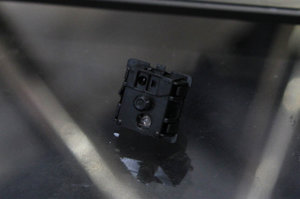Wooting's Optical Keyboard Switch Tricks At Computex 2016
After reading and writing about Wooting’s innovative One keyboard that has optical switches and analog input, we were eager to try out the keyboard for ourselves, which we did at Computex 2016. The long story is below; the short story is that all of those impossible-sounding tricks Wooting has promised actually work.
As a refresher: Wooting, a three-man Dutch startup, used Flaretech optical switches and wrote some clever firmware to develop a keyboard that allows for adjustable actuation points and analog input (that is, you can control your movements with gradations of pressure, so you could for example walk and then run when applying different amounts of pressure to a single key).
Faster, Slower
The Wooting folks had an Overwatch demo set up. With a key press, one of Wooting co-founders, Calder Limmen, toggled the One into analog mode. He explained that the PC would now recognize the keyboard as an Xbox One controller, and you can even map Xbox keys to it. (You can easily toggle back to the digital keyboard mode, which returns the switch function to a simple and familiar on/off.)
In the demo, as you move through a training area, you can walk or run depending on how far down you depress a key. I found this difficult at first. In addition to the fact that you have just a few millimeters of travel to work with, and some of that is consumed by pretravel, it’s tough to be accurate. I imagined being in the midst of a fast and furious FPS firefight and needing to move with precision; it seemed that finding just the right spot in the travel of these switches would be tricky at best.
Additionally, because of the nature of such a key function, you can’t just press down and go; you have to keep your finger hovering in one spot to walk, then depress it more to run, then dial it back somewhat to return to walking speed. It requires constant, though varied, pressure and can quickly wear out your fingers, hand and wrist.
Because of that, and even though the analog switch function worked flawlessly, I was beginning to question the usefulness of such a design--but then I toggled back to the standard digital on/off keyboard mode. The difference was stark; I felt like I was suddenly using outdated technology and immediately wanted to switch back to the analog mode.
Although previous iterations allowed for analog control only on certain keys at a time, such as the WASD cluster, the Wooting team has now figured out a way to enable full NRKO analog input.
Get Tom's Hardware's best news and in-depth reviews, straight to your inbox.
Adjustable Actuation
Not unlike Topre’s upcoming RealForce keyboard, the Wooting One’s switches offer variable actuation. By default, the analog action begins at 2mm, but Limmen said that you can set actuation for anywhere in the travel.
Currently, though, Wooting is limited by Flaretech’s switch design. The light is blocked until 2mm into the travel, so presently you can set actuation only within half of the total switch travel. However, Calder told me that it’s possible for Flaretech to adjust this issue, and upcoming iterations of the switch should offer pretravel of just 1mm, or even 0mm.
Therefore, for now, Wooting can set the actuation point anywhere between actuation and the end of the total travel (a total of 2mm) to the tenth decimal. That is to say, actuation could be set at 2.0mm, 2.1mm, 2.2mm, and so on, all the way to 3.9mm. Presuming that Flaretech enables actuation earlier in the switch travel, the actuation point could then be set to 0.1mm, 0.2mm, 0.3mm, and so on, all the way to 3.9mm.
Obviously there are some sweet spots in there, but it appears that Wooting will let users find their own.
Parlor Tricks
Although not necessarily important for the function of the keyboard, Wooting showed off a couple of features that are more or less just (cool) parlor tricks. The switches are both hot-swappable and modular, so you can use a key puller to yank off the key cap and remove the switch itself from the keyboard. There’s no soldering required, and you don’t even lose functionality.
That’s because of the optical technology. The switch mechanism uses the light to create actions, but (because we couldn’t resist), when Limmen pulled out the switch to demonstrate the hot-swap capability, one of us (ahem, Niels) jammed his finger into the bare socket to see if the input would still work.
It did. That means you could theoretically remove all of the switches from the One and type directly into the sockets, or just above the sockets, and your fingertips would trigger actuations. That, of course, is not practical, but it does speak to the flexibility of the Flaretech optical switches. They’re ripe for innovation, which is something Wooting already figured out.
The switch stems are also Cherry-compatible, so you can opt for aftermarket key caps if you so desire.
Limmen mentioned that when the One ships, it will come with software so you can configure all of the above settings and features, including sensitivity curves. The keyboard will have onboard storage for profiles, too. It’s worth noting that for now, though, making adjustments using the keys seems to work just fine.


Seth Colaner is the News Director for Tom's Hardware. Follow him on Twitter @SethColaner. Follow us on Facebook, Google+, RSS, Twitter and YouTube.
Seth Colaner previously served as News Director at Tom's Hardware. He covered technology news, focusing on keyboards, virtual reality, and wearables.




